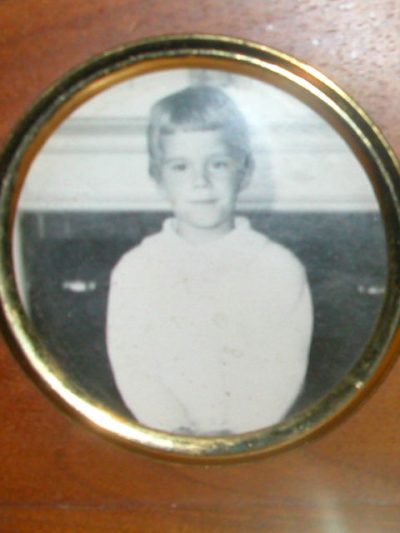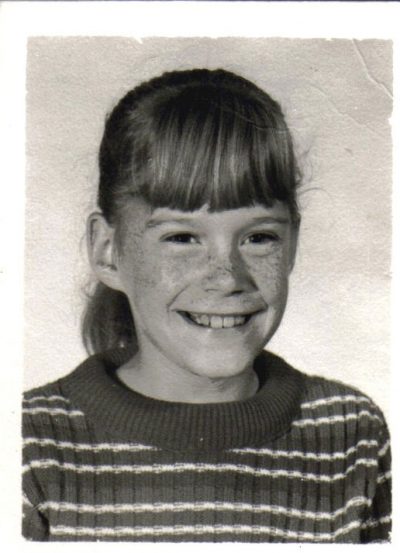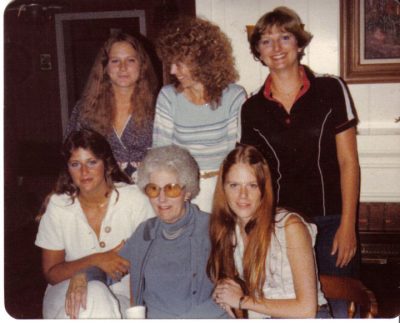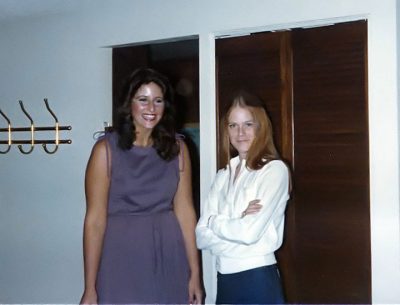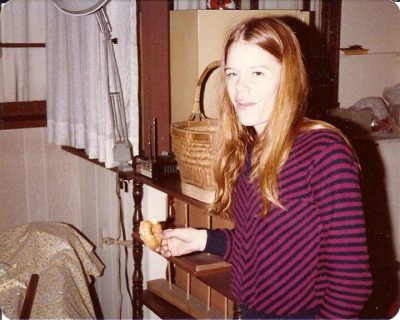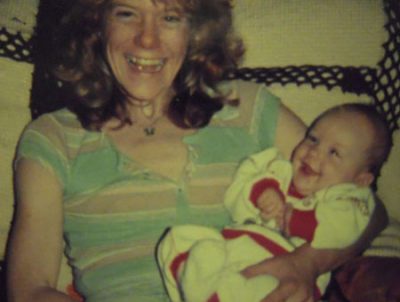To be a prostitute is to walk cold wet streets
in a dangerous night dependent
on the hunger of strangers
vulnerable to their hatred
fists, perverse desires, diseases— Chrystos, “No More Metaphors”
Eryn Beth McClary was born at Sacred Heart Medical Center in Eugene on March 10, 1957. She was the second of three daughters of the late Vernon Kenton McClary and Audrey Lucille (Rodgers) McClary.
Eryn McClary has been a missing person since Aug. 4, 1995.
She was 38-years old when she disappeared. If she were alive today, she would be 61.
At the time of her disappearance, McClary was — in addition to being a daughter, a sister and an aunt — a well-known and well-liked heroin addict and sex worker. Her main stomping ground was Eugene’s Whiteaker neighborhood, the neighborhood I grew up in.
McClary’s case remains unsolved. Although she is still considered a missing person and her body has never been found, no one has any illusions that she is alive.
In all likelihood, McClary was murdered. Regardless, nobody has ever been held accountable for whatever happened to her, and her true fate remains a mystery.
This is the second in a series on our area’s missing people.
Who was Eryn Beth McClary?
“Her nightmare seems far removed from the ‘regular lives’ of most of us. Until you look at Eryn McClary in that snapshot that could be from anyone’s family album. Until you remember … that everyone out on that street is someone’s daughter or sister.”
— Karen McCowan, The Register-Guard, 1995
According to McClary’s niece Jayme Hart, who lived with McClary and other family members at the time of her disappearance, “Eryn was like a second mother to me … She was amazing. I don’t even know how to describe her, really. She was 5-foot-4 and maybe 100 pounds soaking wet, but she had a personality that was bigger than life. When she smiled, her entire face lit up, and you couldn’t help but smile back.”
Linda Parrott, a friend of McClary’s who graduated from North Eugene High School with her in 1975, also recalls McClary having a beautiful smile and a glowing personality “that made everyone want to be her friend.”
McClary’s younger sister, Pamela McClary, recently wrote to me of Eryn’s “beautiful long strawberry blond hair that everyone noticed and commented on” and of her love for cars — especially Camaros.
“Eryn loved her family, her friends,” the letter says. “She was good in school, she liked to water ski and camp. Gymnastics was something she was good at. She had a couple of long-term boyfriends in her life: Scott all through school, and then Ron after. Then she met Leroy and married him too fast.”
Before Eryn got into drugs, she and her sister were very close, Pamela continues. She explains that her sister married Leroy “when she was 21, but it only lasted a year,” and “drugs were what they had in common. When she sobered up she realized what a mistake it was.”
Pamela stresses in her note how much Eryn McClary loved her family. “She was always a daddy’s girl. Eryn was his favorite and they were very close.” Eryn loved her grandparents very much and they were a huge part of her life.
“She was the very best sister you could ever have,” Pamela says.
McClary also loved music. Her favorite band was The Eagles, and she loved movies like The Rocky Horror Picture Show. She was also fond of animals — especially her beloved cocker spaniel, Barney, who Hart says McClary “took almost everywhere with her.”
The dog lived on the streets with her, as well as in motels and at friends’ places, Hart says, “only coming to stay with my grandma when the weather was bad or McClary was going somewhere that Barney wasn’t allowed to be (jail, rehab, etc). She absolutely adored that dog, and he sat by the back door of my grandmother’s house literally for years waiting for her to come home.”
The path of Self-Destruction
It’s difficult to say exactly when McClary’s life began to go haywire. As is so often the case, a culmination of bad decisions, traumatic and unfortunate events led her down the roads of addiction and prostitution.
“Eryn was a bit of a rebellious teenager, which led to her experimenting with several drugs in high school,” Hart says. “She took a liking to LSD and would often drop some before or during school. After graduating, she was introduced to heroin by a boyfriend, I believe.
“After her father passed in 1981, life changed quite a bit for her, my mother and my grandmother in just about every aspect. To cope, McClary turned back to drugs and upped her usage of heroin in particular. Before long, she was hooked.”
A Sept. 30, 1995 article from The Register-Guard, “Have You Seen Eryn McClary?” by Karen McCowan, describes McClary’s dangerous lifestyle unfolding in the aftermath of her father’s death from cancer. McCowan writes that his death “was hard on the whole family, but particularly on McClary, then 23. It meant multiple losses — of a parent who’d been a dominant force in her life, of the family home she’d grown up in, of the family electrical business where she worked.”
McClary’s addiction to heroin, according to McCowan, “was the beginning of a pattern of confrontation, denial, acknowledgement, remorse, promises made, promises broken.”
Bad Dates and Bad Dope
“Anyone who thinks prostitution is some Pretty Woman victimless crime should check out the statistics provided by the Portland-based Council for Prostitution Alternatives. The center, which works to get desperate women out of the risky business of selling sex to strangers, found that 84 percent of its 4,000 clients since 1985 had been assaulted while working the streets. The center’s clients had been assaulted an average of 103 times a year, and half said they had been kidnapped.”
— Karen McCowan, The Register-Guard, 1995
As the official story goes, McClary was last seen in the area of 4th Avenue and Blair Boulevard after her nephew, who spotted her hitchhiking, gave her a ride to the Jesco Club, a longstanding sobriety club for struggling addicts and those in recovery. McClary told her nephew she was planning to attend a recovery meeting at Jesco that evening, but she never arrived there.
At the time, her nephew suspected that based on her makeup and attire — a leopard-print body suit and black knee-high boots — McClary did not actually plan to attend a meeting at the Jesco Club, but more likely had a date planned with a “john” (a prostitute’s client).
According to Jayme Hart, on the night of her disappearance, McClary confided in her sister Pamela, Hart’s mother, that she was nervous about a date she had planned that night — nervous because the john was young, and many younger men would “act entitled, rough them up and sometimes not even pay them.”
Young or old, it is reasonable to assume that a man killed Beth McClary. Since time immemorial, men have treated prostitutes as disposable and easy prey. In the Pacific Northwest, men such as Gary Ridgway, aka the Green River Killer, have gotten away with murdering prostitutes for decades before they were caught. Others were never caught and, unfortunately, some never will be.
But, if McClary was not murdered by a sadistic john, what happened to her?
One theory is that she overdosed on drugs and her body was hidden somewhere.
“Certainly there are other plausible possibilities,” McCowan writes. “There was some bad heroin on local streets about then. But her body would likely have been discovered by now if she had died accidentally.”
According to Hart: “A few months after McClary disappeared, somebody wrote on the back of one of the missing person flyers at Albertsons at 18th and Chambers that she ‘overdosed while partying,’ and they supposedly dumped her body in the woods around Fern Ridge Reservoir … That was probably the night I realized she’d died and I wasn’t going to see her again, whether what was written on the flyer was true or not.”
McClary’s older sister, DeLynn Tucker, remembers the same note, though she says it was found near 8th and Van Buren, which she says was written in “broken English” and may have been authored by one of the Hispanic drug dealers McClary knew at the time.
But the overdose theory seems implausible because, while some drug addicts may abandon people while they’re overdosing if they’re scared of getting in trouble with the law, rarely do they have the will or the way to successfully dispose of or hide a body. This requires a greater level of premeditation and sophistication than can be expected from most junkies. People overdose all the time, and their bodies are usually easily found in alleys, motel rooms, crash pads, parking lots, etc.
Even in the late summer of ’95, McClary’s family members were largely skeptical of notions that she fatally overdosed on drugs and subsequently was ditched somewhere, or that she left town to avoid arrest. She had a warrant at the time she went missing but she had no history of fleeing town to avoid arrest, and she had plans to enter a treatment program for substance dependency.
Plus, she would never abandon her dog Barney.
McClary’s disappearance was ominous and uncharacteristic, and most who knew her feared the worst.
“We believe she got caught up with the wrong people, possibly crossed somebody and they did away with her,” McClary’s brother-in-law, Scott Tucker, writes me. “People need to know she is one of many good people who turn down the wrong path and get caught up in the darker world.”
Buried Truths and ‘The Darker World’
“If something’s happened to her, we will find whoever did it — this case is not being ignored because of her lifestyle.”
— Eugene Police Department, in the RG Sept. 30, 1995
Several years ago, a woman known as TB, an acquaintance of some members of the McClary family who had a troubled past, approached Scott and DeLynn Tucker at a bar to tell them she knew what happened to McClary.
According to TB, McClary was murdered by two men, both methamphetamine dealers associated with the Free Souls Motorcycle Club who lived on the outskirts of Junction City in the ’90s near what is now the High Pass Winery.
TB claims McClary’s body is buried on the Leval Road property, and that she was killed by these men because they thought she was a “snitch.” She believes other bodies are also buried on the property.
TB, who the Tuckers felt was sincere despite her credibility issues, said she now felt safe talking about what happened to McClary because the men responsible for killing her were no longer alive, and that she didn’t come forward sooner because she was scared of their retaliation.
TB also said she would be willing to take McClary’s family and the authorities to the exact location where McClary was buried.
Scott and DeLynn Tucker say they went to the police with TB’s story but, as far as they know, it was never investigated.
TB declined to be interviewed for this story.
Over the years, McClary’s family members have dealt with numerous Eugene police detectives assigned to her case and, while that experience has generally been positive (Scott and DeLynn Tucker speak fondly of former Eugene police detective Pat Ryan), they feel left in the dark about what police know about McClary’s disappearance. It has been several years since anyone from McClary’s family has been contacted by law enforcement about it.
Linda Parrott believes that a man named Neal Falls may have been responsible for McClary’s disappearance.
Neal Falls
“It’s likely that Mr. Falls is a serial killer.”
— Lt. Steve Cooper, in statement from the Charleston, West Virginia, Police Department, July 2015
“It is a surprise. He was not on our radar at all.”
— Sgt. Rich Charboneau, Springfield, Oregon Police Department, in the RG, July 2015
On July 18, 2015, native Oregonian and Springfield resident Neal Falls, 45, was shot and killed in Charleston, West Virginia, during an assault on sex worker Heather Saul. She was able to snatch his firearm from him during a struggle that ensued almost immediately upon entering her home for a date arranged on Backpage.com, a website used to arrange sexual liaisons.
Falls, a professional security guard who had no criminal record other than minor traffic violations, had been contacted by police in more than 20 states over two decades due to suspicious activity that led them to run background checks to see whether he was wanted.
What police learned about Falls after his death was unsettling.
According to a July 29, 2015 NBC News report: “Police found what they described as a ‘kill kit’ in the trunk of Falls’ car — including handcuffs, several long knives, a box cutter, two axes, a machete, a sledgehammer, a bulletproof vest, another gun, shovels, a rubber tub large enough to hold an adult, and bleach and other cleaning supplies that could be used to help dispose of a body.”
In his pocket, Falls had a handwritten note listing names and phone numbers for sex workers in the area. Police suspect the women on the list were intended to be future victims.
Media and police reports indicate that Falls has been investigated in connection with the deaths and disappearances of sex workers in at least nine states, including Oregon.
While Saul is thus far his only confirmed victim, Falls is believed to have been responsible for the deaths of several sex workers near Las Vegas, Nevada, during the early 2000s. Falls worked security at the Hoover Dam from 2000-2007 before being fired for erratic and inappropriate behavior, including sexual harassment.
A timeline of events provided by the Neal Falls Investigation website indicates that Falls, born in Springfield on Sept. 24, 1968, lived in Oregon until his father died in Greensburg, Kansas, in July of 1995.
After his father’s death, Falls relocated to Kansas for a short period before returning to Oregon in 1996.
Is it possible that during the summer of 1995, Falls, who was 25 years old at the time and could have been one of the abusive young johns that McClary worried about, killed her? Leaving or coming-and-going from the state to handle family matters elsewhere certainly would’ve been a convenient way to conceal involvement with a murder.
Regarding Falls, Hart says: “My mom and I wondered about that guy, too. I showed her his picture when the story originally broke, and she said he looked familiar, which seemed to kind of freak her out. From what we heard, however, EPD was on it and somehow ruled him out. I still think it’s a possibility, though I don’t know where to even start looking into that.”
It may be that EPD was either able to rule out Falls as a suspect in McClary’s disappearance or that there simply was no evidence to make a connection. A July 24, 2015, story in the RG quotes EPD spokesperson Melinda McLaughlin saying, “We have no cases at this time that have been identified as related.”
We will never know how many victims Falls had, and we may never know if McClary was one of them.
Regardless, it is highly unlikely that Heather Saul was his one and only victim.
“I believe Heather [Saul] did stop a serial killer,” Lt. Cooper of the Charleston Police Department told NBC News in late July 2015. “I believe when she killed Mr. Falls that [she] ended what was likely numerous violent crimes.”
By turning the tables on Falls, Saul may have unknowingly avenged his past victims while preventing him from harming anyone ever again. That Falls’ miserable life was put to an end by a sex worker he probably intended to rape and murder is, if nothing else, an eerie tale of poetic justice.
Brenton Gicker is a registered nurse who lives and works in the Eugene/Springfield area. He can be reached at outfromthevoid@yahoo.com. If you would like him to explore a case for this series, please contact him.
Other Cold Cases
These cases rattle some primitive part of our brain, one where the world is bigger, more mysterious, and more inexplicable than our daily grind suggests. — Jeremy Lybarger, The Encyclopedia of the Missing
Somebody has to speak for the dead. — Bob Walker, Eugene Police cold case squad, KVAL, February 2012
Beth McClary is one of many local women who have gone missing or were murdered and nobody was ever held accountable for it. The following are just a few of the many cases that have never been solved:
Benita Gay Chamberlin (DOB 10/27/53) was 24-years old when she disappeared Feb. 23, 1978 after visiting her newborn at Sacred Heart Hospital in Eugene. She had given birth on Feb. 13 but her baby remained hospitalized due to prematurity and low birthweight. On the day she disappeared, Chamberlin was ecstatic to learn that her baby girl would be able to go home with her later that day. But Chamberlin never returned to the hospital. Her purse was found on the ground on the University of Oregon campus and her vehicle was found in a nearby parking lot. She seemingly vanished.
Chamberlin was separated from her husband and in the process of a divorce at the time of her disappearance. According to The Charley Project, “Her coworkers said she was well-liked and a reliable employee, and she was also described as a dedicated parent who would never have left her three children, the oldest of whom was seven years old in 1978. She is a graduate of Churchill High School.”
News stories published about Chamberlin’s disappearance at the time focus on a woman’s severed thigh that was found in a dumpster the same week Chamberlin went missing. Eventually it was determined that the severed thigh belonged to another woman, Pamela Lee Bruno, also 24-years old, of Springfield, who had been murdered by a trio that included her own husband during a drug-fueled orgy that turned heinously violent. Very little has been made public about what may have happened to Chamberlin.
Joni Marie Grigsby (DOB 5/5/62) was 33-years old when she was murdered on June 2, 1995. Her body was found under the bridge over the Willamette River connecting Glenwood to Springfield. Grigsby — who was a drug-addict and a prostitute — had been sexually assaulted and strangled to death. Police reports indicate that her boyfriend at the time acted suspiciously after her death and that more than one person may have been involved in sexually assaulting and killing her.
Sharon Marie Hiller (DOB 8/28/67) was found deceased on Nov. 28, 1992. She was 25-years old when she was strangled to death. Sharon was last seen alive when she left her job at the Alaska Bush Company (a now defunct Highway 99 strip club where she worked as a dancer) three days earlier at approx. 2:30am. Her body — which was hidden under a log and debris — was discovered along the south bank of the Willamette River near the Greenway Footbridge. Sharon struggled with addiction and sometimes supplemented her income with prostitution. She left behind a son.
Rebecca Kathleen Reid (DOB 12/17/59) was 37-years old when she was abducted at knifepoint as she was closing the (now defunct) Grocery Cart convenience store that she managed on Highway 99 in Eugene. According to The Charley Project, Rebecca “was working at approximately 1 am on Jan. 27, 1997 when a bystander collecting beer bottles witnessed an unidentified Caucasian male forcibly leading Reid out of the store and into his vehicle, just prior to the store’s closing time.”
At the time of her disappearance, Rebecca was the happily married mother of a young son. EPD received more than 800 leads in her case but nobody was ever charged with her disappearance. Rebecca’s sister, Chris Yoder, is quoted in a Feb. 10, 2017 KVAL News story saying “Somewhere in that police department’s basement is a box with my sister’s name on it and nobody is doing anything about it.”
Candice Roy was only 17-years old when her dead body was found on June 6, 1988 in a brushy area near the intersection of Hoyt Avenue and Castry Street in the Santa Clara area of Eugene, several blocks from where she lived with her parents. Roy — who was sexually assaulted and strangled to death — had been reported missing by her parents a few days earlier. She was scheduled to graduate from high school the following week.
According to a June 5, 2013 story from The Register-Guard “Investigators say that despite their best efforts, they never could identify her killer. But they remain hopeful that someone who remains alive today knows who’s responsible for Roy’s death and will eventually provide them with that long-awaited information.”
Azucena Terrazas (sometimes referred to as Azucena Terrazas Rodriguez) was 28-years old when she was murdered by strangulation in early February of 2002. Azucena was college-educated and had moved to Eugene from her hometown of Oaxaca, Mexico in 2000. Azucena was last seen alive at her workplace (she was a clerk for DolEx, a now defunct currency transmitter serving the Latino community) at 940 West 7th in Eugene on the evening of Feb. 7, 2002. Her dead body was found there the next day. On the night she was murdered, a severe windstorm had struck the city.
A Feb. 7, 2003 story from The Register-Guard says that “Investigators believe she didn’t know her killer, but that he had watched her movements for two or more days to hatch a plan.” The article suggests that the killer intended (but failed) to rape her and that he may have been responsible for a similar murder that happened in October of 2001 in San Bernardino County, California. According to news reports from 2002 and 2012, an elusive man by the name of Sergio Zavala-Hernandez is a “person of interest” in her case.
Angela Gay Wilson was 44 years old when her body was found on Oct. 2, 2005. According to Oregon Crime Stoppers, “Angela Wilson was found floating in the Willamette River, downstream from Jasper, Oregon. Angela was homeless and frequented transient camps in Glenwood and Eugene, OR.” Her case is categorized by police as a homicide. A Jan. 1, 2006 article in The Register-Guard says “Wilson was one of several transients who died near the river during the summer, sending a wave of fear through the area’s homeless population. However, detectives say most of the deaths were accidental or caused by medical problems, and all appear unrelated.”
Other missing or murdered women in Lane County (all unsolved cases): Wendy Marie Dehoop (missing since 2005); Phyllis Amelia Dentel (murdered in 2001); Janice Marie Dickenson (murdered in 1986); Betty Jean French (murdered in 1975); Gladys May Hensley (murdered in 1986); Vicki Lynn Hollar (missing since 1973); Gayle Elizabeth Leclair (murdered in 1973); Anna Cornell Magnuson (missing since 2002); Becky Rae Martin (murdered in 1975); Christine Ann Nelson (missing since 1986); Nanci Terese Nelson (missing since 1998); Judy Ann Parker (missing since 2016); Linda Rachel Pleva (missing since 1981); Rhonda Gayle Sansovich (missing since 1988); Janet Lynn Shanahan (murdered in 1969); Deborah Lee Tomlinson (missing since 1973); Geraldine Spencer Toohey (murdered in 1988); Shirley Anita Wallace (murdered in 1975); Kathleen Marie Woods (murdered in 1982), etc.
For More Information
McClary Beth McClary on WikiTree
National Missing and Unidentified Persons System (NamUS)
Correction/Clarification
The methamphetamine dealers associated with the Free Souls Motorcycle Club who lived on the outskirts of Junction City TB alleges murdered McClary lived near, not at, High Pass Winery, according to winery owner Dieter Boehm.

